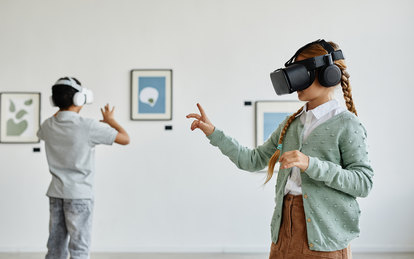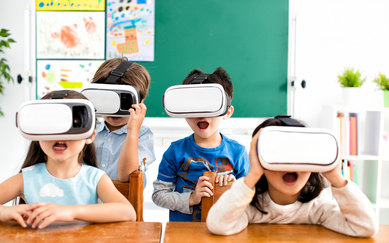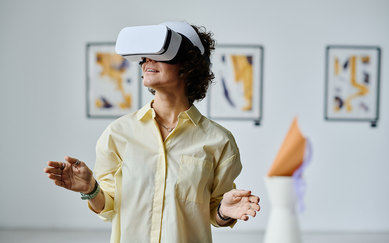How museums utilize virtual reality to attract more visitors and increase revenue

Virtual reality has been around since the 1980’s but has only recently entered the mass market. Due to recent advancements, virtual reality is now within reach of most consumers. In 2021, Facebook announced that it would embrace the technology, rebranding as Meta, and pushing virtual reality beyond mere gaming into a more developed metaverse. Museums in particular can benefit from the broader adoption of virtual reality to attract more visitors, provide a more immersive visitor experience, and generate additional revenue.
Virtual reality (VR) is a simulated experience in which users interact with a computer-generated environment. It can facilitate a more dynamic museum experience by allowing visitors to interact with the museum’s collection virtually. Rather than simply having a static view of an object, museum visitors can interact with the object in a virtual, yet realistic space. They can zoom or pan around the object, and instantly access more dynamic content, such as videos or interactive graphics. VR can also provide museums invaluable insights into visitor behavior during this interaction. Metrics like length of visitor engagement could be used as an inexpensive testing ground for future exhibitions before they are built in the real world.

Virtual reality can even transform an ordinary field trip to the museum into an unforgettable experience without students ever leaving the classroom.
Because the experience is digital, VR can be accessed anytime from anywhere in the world. Using VR, a museum can provide instant, around-the-clock access to millions of new visitors every year. It can even transform an ordinary field trip to the museum into an unforgettable experience without students ever leaving the classroom.
VR can also enhance current revenue streams. In a virtual environment, museums can rent out virtual venues and provide unlimited virtual seats to seminars, live programs and other museum events. They can offer virtual collaborative spaces and create new, virtual communities. VR technology can even be used to supplement a museum’s traditional gift shop with a virtual e-commerce environment. Visitors can customize products, view souvenirs in 3D, or virtually try on clothing - things that would have been impossible by merely shopping online. And because a museum knows more about its VR users than its traditional visitors, it can advertise relevant content in a more targeted way.
How can museums take advantage of the benefits of virtual reality? VR can be accessed in many ways, but all involve a physical device through which the user views a software application. Devices range from simple and inexpensive, to more advanced and costly.
Museums can take advantage of the simplicity and low cost of the devices on the lower-end of this spectrum. These budget-friendly viewers use the visitor’s own smartphone to view virtual content, allowing anyone with a smartphone and internet access to inexpensively access the museum’s content. Google first popularized these types of viewers with their Cardboard and Daydream headsets. Today, there are numerous vendors offering custom versions of these viewers for as little a few dollars per piece, presenting a branding opportunity for museums as well.
Higher end devices, like the Meta Quest or HTC Vive, offer a much more interactive and immersive experience. These devices consist of a headset with specialized lenses, however instead of relying on the user’s smartphone to run software, the headset contains all of the necessary hardware, and relies on the user’s high speed wireless internet connection to deliver content. These devices are also paired with hand controllers that allow the user to interact with virtual content, resulting in a much more immersive and richly rewarding experience. These devices, however, can be cost prohibitive. The popular Quest 2, for example, retails for $399, while other devices can be over $1000, and may result in a more limited audience.

Embedding virtual reality into an exhibit at the museum is a uniquely interactive way to experience what would otherwise be an ordinary and static exhibit, greatly enhancing the visitor experience.
While many may be visiting museum VR content on-the-fly at home or school, some museums have begun offering more advanced and immersive VR experiences. These can be classified into three basic types: the exhibit-based experience, the standalone experience, and the virtual proxy.
The exhibit-based experience offers visitors an immersive way to experience a traditional exhibit while at the museum. One example is the London V&A Museum’s Curious Alice, an exhibition that explores the Lewis Carroll classic novel Alice in Wonderland. Through their VR headsets, museum visitors are transported to various worlds where they interact with characters from Carroll’s novel. This is a uniquely interactive way to experience what would otherwise be an ordinary and static exhibit, greatly enhancing the visitor experience.
The Night Cafe: A VR Tribute to Van Gogh by Borrowed Light Studios is an example of a standalone experience. Not associated with any particular museum, this VR app lets users take an imaginary and immersive journey into the artist’s works. Museums could partner up with VR developers or host competitions for students to create VR experiences for their existing collections, transforming an existing experience into something new and exciting.
However, a totally unique way to experience a museum is the virtual proxy. Rather than merely enhancing the experience, VR is substituted for a physical museum, allowing users to visit museums that would otherwise be inaccessible to them. Through a virtual proxy experience, museums can cut operating expenses while having a global reach.
The Museum of Science Fiction is currently exploring this new type of museum experience and is focused on its educational potential. “To help explore this new horizon and its potential impacts, the Museum will open its first VR gallery in 2023,” says Greg Viggiano, Director of the Museum of Science Fiction. “This virtual reality experience will begin with ‘Creating Consciousness: Computers and Robots in Science Fiction.’ This exhibition examines a machine’s capacity to understand humanity and includes a VR tour inside of a quantum computer.”
As museum designers, we at SmithGroup rely on VR technology in our design process as well, particularly to help our clients understand museum spaces before they are built. “As valuable as virtual reality is to designers, our clients truly gain the largest benefits,” says David Fersh, Architect and Design Technology Leader at SmithGroup. “The user can move freely through a space and understand what it feels like through an interactive experience. For our clients, this means greater transparency and decision-making abilities in the design process.”
Ultimately, virtual reality provides a unique and transformative way to experience a museum, benefiting not only the visitor, but the museum as well. Many museums have already adopted this technology, while others are starting to catch up. It is easy to see how virtual reality will revolutionize the way we experience museums in the future.